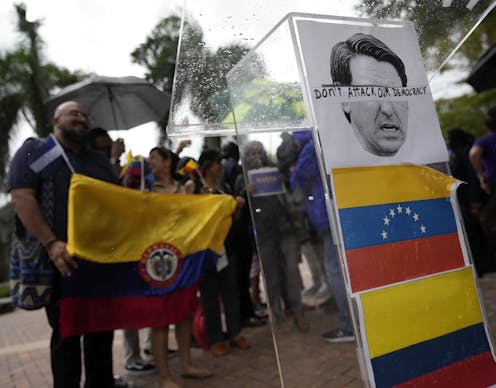
The Republican governor of Florida, Ron DeSantis, is facing a criminal investigation for sending two planes full of Latin American asylum-seekers to Martha’s Vineyard, a wealthy Massachusetts island where former president Barack Obama owns a home.
Not to be outdone, his Republican counterpart in Texas, Greg Abbott, also dispatched two busloads of mostly Venezuelan migrants, including a one-month old baby, to the Washington, D.C. residence of Vice-President Kamala Harris.
The stated goal of DeSantis and Abbott was to bring the alleged crisis along the U.S. southern border to the very doorsteps of East Coast liberals.
“You could probably fit a dozen immigrant families in Barack Obama’s pool house and another five or six in the pantry,” sneered Tucker Carlson of Fox News.
At first glance, this sort of thuggish and potentially illegal political theatre dates back to 2016, when Donald Trump turned white grievance into the lodestar of today’s GOP.
Eager to replace Trump as the Republican leader, DeSantis and Abbott want to show that they can “own the libs,” bully brown people and generally carry on the Make America Great Again movement.
Yet these relocations also reflect specific hatreds that date back to the very beginnings of European settlement in North America, when small numbers of English fortune-seekers and servants built a fragile toehold in Virginia while a larger, better organized group of Puritan families came to Massachusetts.
Frontier violence
Almost from the outset of colonization, the Puritans in Massachusetts were able and willing to displace the resident Pequots, Wampanoag and Narragansett people and establish fast-growing communities of white settlers. The Virginians, meantime, struggled to survive amid the powerful Powhatan Confederacy.
Investors and Crown officials in London recommended better relations with Indigenous people after a harrowing attack by Powhatan’s warriors in 1622. But Virginia officials fumed that people in European capitals had no idea of life in American woods filled with “barbarous, perfidious” foes.
Throughout the colonial period, frontier settlers seethed that eastern audiences did not understand the Delawares, Shawnees and other “savages.” In 1755, traumatized settlers from western Pennsylvania dumped the mutilated bodies of some of their neighbours (probably killed by Delawares) in front of Philadelphia’s State House, cursing the “Quaker principles” (meaning pacifism) of the cosseted city.
By that time, the tobacco and rice plantations of the southern colonies relied on Black slaves. In effect, every slave-holding household became a frontier — always on guard against the non-white enemies around them and bitterly resentful of those who lived in the mostly free and white regions to the north.
In the 1830s, the champion of southern and western rage was President Andrew Jackson, a Tennessee man of Carolina origins whose main priority was the mass deportation of Choctaw, Chickasakaw, Cherokee and Creek peoples from Mississippi, Alabama and Georgia.
Jackson was also determined to destroy the escaped Black slaves who had formed small communities in the wilds of Florida, calling them and their Seminole and Creek allies a “murderous rebellious barbarous Banditti.”
When tens of thousands of northerners denounced Jackson’s “Indian removals” as cruel and unnecessary, his supporters raged that holier-than-thou northerners never had to tremble at the thought of an Indigenous or Black man at their door.

Comfortable elites
Frontier ideology rested on two assumptions: First, that non-white people always threatened the physical safety of the nearby whites; and second, that people from the predominantly white northern and eastern regions never understood that threat.
This was a populism based on region and race rather than class. The issue wasn’t that East Coast elites were wealthy, but rather that those elites seemed comfortably distant from the epic violence along America’s frontiers.
Similar conflicts occurred in other zones of settler colonialism, including Canada. In the United States, however, frontier whites had far more political power. And whenever that power came into question, the old hatreds flared up again, even when the actual dangers of frontier violence were long gone.
After northern radicals and progressives supported Black voting drives in the early 1960s, for example, white supremacist groups in Louisiana tricked the Gilmores, a Black family of 10, into boarding a bus bound for the home of a civil rights supporter in New Jersey. (The Gilmores were apparently told that good jobs were waiting for them.)
Read more: Ron DeSantis and Greg Abbott pull from segregationists' playbook with their anti-immigration stunts
At a news conference organized by the local White Citizens’ Council, the men responsible chortled that the New Jersey activist should “take a personal interest in getting the Gilmore family settled.”
An Arkansas lawyer and white supremacist also targeted single Black mothers with posters declaring that Robert F. Kennedy, the U.S. attorney general and Massachusetts native who supported civil rights, “assures you a grand reception to Massachusetts. Good jobs, housing, etc. are promised.”
When politicians like DeSantis and Abbott target the predominantly liberal cities of the East Coast with relocation stunts, they’re drawing from a deep well of racialized fury that has long boiled beneath the surface of America’s political geography.
Look for their choreographed deportations to continue, ginning up Americans’ increasing contempt for each other while wearing down the republic’s fragile ideal of finding a “more perfect union.”
Jason Opal receives funding from the Social Sciences and Humanities Research Council of Canada.
This article was originally published on The Conversation. Read the original article.







